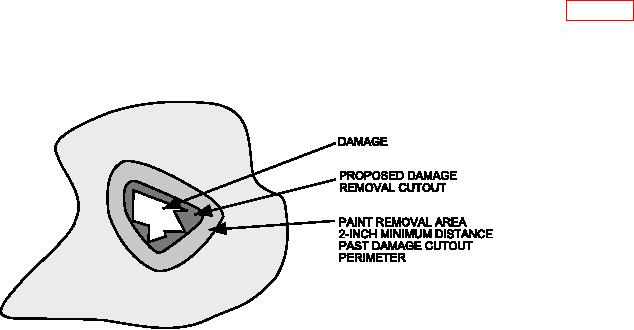
TM 1-1500-204-23-11
REPAIR PROCESSES
6-1. SURFACE PREPARATION. Paint stripping of
drying of moisture removal process, the paint should
composite parts has been a source of concern for
be removed prior to conducting drying procedures.
many years because the techniques used to strip
metal are usually too harsh to strip composites.
a. Process Overview. Perform a solvent wipe prior
Stripping composites is normally accomplished by
to removing paint to prevent driving contaminants and
power sanding to the primer then hand sanding
oils into the composite. Paint and any other surface
through the primer. Chemical paint strippers can
coatings within the repair area boundary must be
seriously damage epoxy matrix resins; their use is
removed prior to any surface repair activity. The
prohibited on all polymer matrix composites. Some
coatings should be removed from the repair area in
abrasive blasting processes have great potential to
accordance with the procedures deined in the system
harm the matrix and ibers as well. The type of
speciic technical manual. During the paint removal
blast media and pressure can affect the removal rate
process, it is crucial that no additional damage be
and also can damage the surface of the composite
caused by excessive material removal. Great care
materials. Abrasive grit (sand) blasting and glass
must be taken to not sand into composite ibers
bead blasting are never appropriate for composite
or remove excess material from metallic structures.
paint removal. Certain methods such as polymer
Generally, the only ield authorized method for paint
modiied corn or wheat starch blasting, CO2 blasting
removal from composite substrates is sanding. Pneu-
and plastic media blasting may be acceptable. These
matic sanders are preferred for initial paint removal.
methods should only be performed on large parts by
Other types of power sanders should not be used
experienced personnel, and only when authorized by
because of the high potential for laminate damage.
the system speciic technical manual or engineering.
Using a pneumatic sander, remove the paint until the
Water jet blasters can severely damage a polymer
primer is exposed. Switch to hand sanding to complete
matrix material and must not be used on composites.
the paint removal process. The paint removal must
Laser stripping and lashjet methods are being used
extend at least 1 inch beyond the repair area. Paint
more every day and have proven to be an effective
must be removed from repair surfaces to ensure ade-
method in the removal of paint from a composite
quate adhesion of bonded repairs and adequate friction
surface. Consult with engineering prior to using other
in bolted joints. The following methods will remove the
paint removal procedures other than sanding.
paint or surface coatings from Carbon/Epoxy (C/EP),
Boron/Epoxy (B/EP), Aramid/Epoxy (A/EP), Fiberglass/
6-2. PAINT REMOVAL PROCESS. Paint removal
Epoxy, and Carbon/ Bismaleimide (C/BMI) composites
(including primer) is required prior to patch installa-
in preparation for a bonded or bolted repair. Always
tion because in adhesively bonded joints the paint
refer to the system speciic technical manual for any
to laminate bond is considerably weaker than the
particular paint removal procedures. See igure 6-1
adhesive to laminate bond. In bolted joints the paint
for a typical damaged area and paint removal outline.
to laminate bond is weaker than the sealant to lam-
inate bond. In cases where the paint may inhibit a
Figure 6-1. Paint Removal Zone

